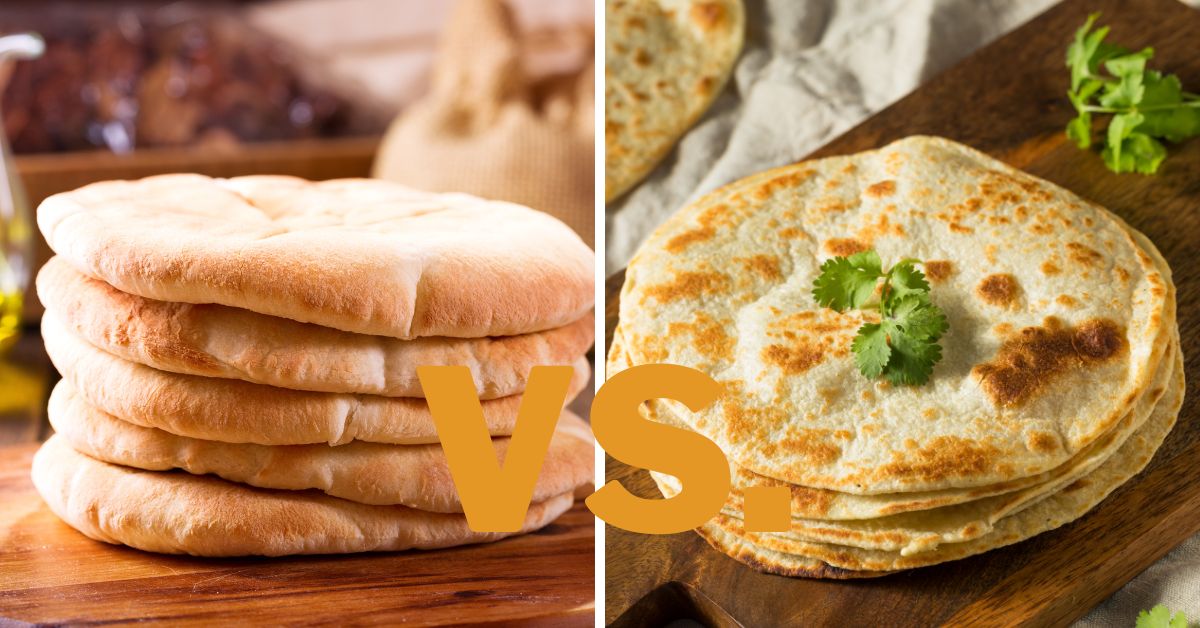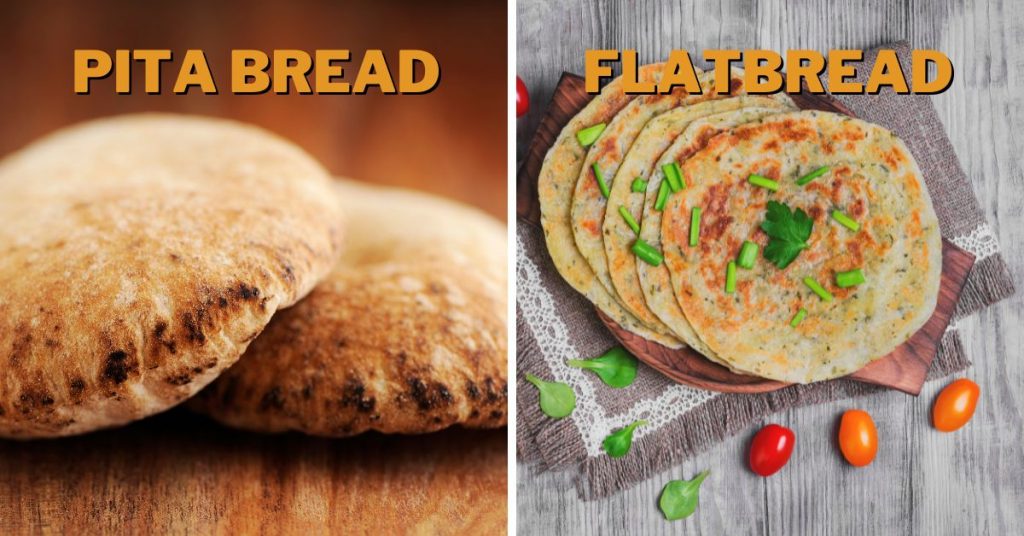Pita Bread vs. Flatbread: Differences & Which Is Better?

Both are similar, easy to make, and incredibly delicious and versatile. Although people usually mistake one for another or consider them the same type of bread, some differences make them equally unique. So what are the differences between pita bread and flatbread?
The most significant difference between pita bread and flatbread is that pita bread is leavened, while flatbread isn’t. Pita bread is used as a base bread in the Mediterranean, the Balkans, and the Middle East. Made of salt, flour, and water, flatbread is used as a base bread in many countries and has many purposes.
Although pita bread is a type of flatbread, the taste, appearance, consistency, and texture of the two are very different. The uses of pita bread and flatbread are similar but aren’t identical. Therefore, in the following text, I will explain the differences between pita bread and flatbread and their uses.
Pita Bread and Flatbread: Differences
First, pita bread is leavened bread, while flatbread is not. In addition, flatbread often contains additional spices and flavorings, while pita bread is usually plain. Except for these differences, there are other ones between these two types of bread.
Origins
Pita bread originated a very long time ago, about 4,000 years ago, in the Mediterranean and Middle Eastern Countries, where it is still very popular. Over time, it has spread as a cultural influence in the Balkans and Eastern Europe.
Flatbread is even older. It originated in Egypt about 6,000 years ago and is still popular in that part of the world. With time, it has made its way through Western Europe, so it may be very likely that this bread had inspired the pizza dough.
The fascinating thing about these two types of bread is that they are still very popular and frequently used in the territories where they originated. This is the most significant proof of their wide application and the simplicity of their making processes.
Ingredients, Preparation and Taste
Pita bread and flatbread contain the same ingredients, i.e., flour, water, and salt, but pita bread also contains a leavening agent.
The preparation process is more or less the same. It includes mixing the water, salt, and flour, like pita bread, the leavening agent, and kneading the dough into a single and stable mass.
Since flatbread doesn’t have a leavening agent, it doesn’t need time to rise, but it does need to be left to rest, and then it is kneaded again. It can also contain spices and flavorings, but they are optional.
Pita bread needs time to leaven, which often is about 20 to 30 minutes. After it leaves, the pita bread is larger but softer and needs kneading. Usually, pita bread doesn’t contain any seasoning other than salt, but if you want to, feel free to add some.
After the dough has been properly leavened and kneaded, the pita bread or the flatbread is divided into pieces. The pita bread pieces are usually spread by hand without using a rolling pin, but it isn’t a crime if you roll them again.
The flatbread pieces are traditionally rolled with a rolling pin to flatten out.
Pita bread and flatbread are pan-made bread types, which means they are baked in a pan on the stove and not oven-baked. However, there are exceptions; therefore, you can find some oven-baked variations of these types of bread, which are delicious.
In terms of taste, pita bread and flatbread resemble one another, which is expected since they share many of their primary ingredients. However, due to the lack of a leavening agent, flatbread is a bit rougher and more intense than pita bread.
The leavening agent in the pita bread creates air pockets in the dough, making this bread softer than flatbread, airier, and generally more gentle and elastic.
They taste delicious, with the pita bread being the milder-tasting one, whereas the flatbread’s taste depends on the potentially added flavorings.
Appearance and Size
When you first see them, you won’t be able to tell which is pita bread and which is flatbread. Their appearances before baking are almost identical. The only thing that could tip you off I the size.
When leavened, the pita bread almost doubles in size, while flatbread remains the same. Another difference between these two breeds is the density. The flatbread is denser and firmer than pita bread.
When baked, the flatbread is harder and flatter, while pita bread is fluffier and softer than flatbread. They both have golden colors when they’re done.
They don’t have a standard size; it mostly depends on who’s making it and for what.

Uses and Popularity
Pita bread is in wide use as a topping base or filling wrapper. For example, the Greek Souvlaki is wrapped in pita bread. It can also be used as a snack bread, topped with spices, olive oil, or butter, and dipped in a dipping sauce, hummus, baba ganoush, or another creamy delicacy.
In essence, you can use flatbread as you use regular bread. You can also use it as a base for pizza or flatbread sandwiches. It doesn’t have a particular use, as it has been invented to be universal and applicable in many ways.
Because flatbread isn’t a leavened bread, it isn’t as elastic as pita bread, so you can’t use it as a wrapper, as it will likely break. However, it holds a lot of filling and is perfect as a base for topping.
While pita bread is most popular in the Middle East, the Mediterranean, the Balkans, and Eastern Europe, flatbread is more popular in Africa, India, and Western Europe. Given that the USA is a colorful collection of many cultures, pita bread and flatbread are popular there.
Nutrition
Since they are both pieces of bread, they naturally contain a lot of carbohydrates and a certain amount of sugar. [1] [2] Because they contain salt, they have some amounts of sodium. The leaving agent of the pita bread likely contains yeast, so the pita bread may contain some bacteria beneficial for gut health.
All in all, they aren’t rich sources of micronutrients, as they contain just a few plain ingredients.
On the positive side, both flatbread and pita bread are less likely to cause or trigger allergies and are suitable for sugar and glucose regulation.
Variations
With their popularity, these two bread have spread worldwide and have inspired other types of bread to come from them. Focaccia bread, Matzah, Lavash, Frybread, Chapati, Naan, and Roti are variations of pita bread and flatbread.
These variations developed over time and have changed enough to be called unique, but still, their main ingredients are water, salt, and flour.
Pita Bread vs. Flatbread: Which Is Better?
If you need a topping base or are in the mood for a pizza sandwich, flatbread is your solution; if you are craving a wrap or a dipping bread, go for the pita bread.
It is impossible to label one of these as better, as they both shine best when properly used. Same, but different; they have advantages and disadvantages, but calling one better, is simply untrue.
What Is the Best Way to Serve Pita Bread?
Pita bread is best to serve as a wrapper or a dipping bread. As it is universal and nonrestrictive, there are many pita bread recipes you could try. Chop some vegetables and prosciutto and wrap them up.
Fry some meat and French fries, and you’ve got yourself a Souvlaki. Smear some olive oil and sesame seed over it, and you have a dipping bread. Dip it in whatever you like and enjoy.
What Is the Best Way to Serve Flatbread?
Like pita bread, flatbread has many uses, mainly as a base dough; you can top it with whatever you like or sandwich bread. You can also use it instead of regular bread, as that was its original purpose.
Which Is Healthier: Pita Bread or Flatbread?
Since flatbread and pita bread have very similar nutritional value, they are more or less the same health-wise. Since there is not much to offer, nutrition-wise, they aren’t exceptionally healthy, but they aren’t harmful either. Entire civilizations ate them daily, and they thrived on them.
The deciding factor is what you pair them with. Pairing them with greasy, fatty food will be less healthy than paired with fresh and energizing ingredients.
